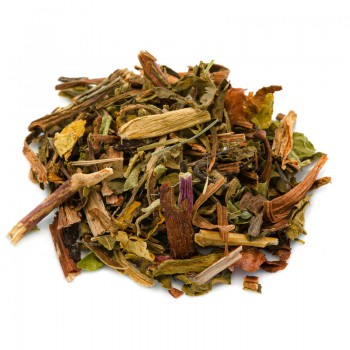Desmodium, or desmodium, is a plant considered for centuries a natural remedy in African and South American folk medicine . In phytotherapy it was used against liver and digestive diseases, consumed with the infusion of the leaves even in case of skin or respiratory problems.
Even today it is therefore often used to contribute to other pharmaceutical treatments, thanks to its characteristics.
Desmodium: properties and benefits
The properties of desmodium, used for centuries, have been analyzed from the 1960s onwards, to investigate its beneficial characteristics.
Knowing the historical use of desmodium decoctions in the treatment of hepatitis, the main pharmacological properties of Desmodium leaves, which are hepatoprotective, have been discovered.
The beneficial effect of desmodium for the liver, against toxic compounds, is linked to its content of substances called triterpenoid saponins.
Some of these desmodium substances protect liver cells from damage induced by hepatotoxic substances, help normalize liver transaminase levels.
In practice, desmodium acts by increasing the resistance of liver cells in inflammation or in cases of liver failure.
It allows an improvement in transaminases, since these enzymes increase during cellular lesions, and act on the regeneration of damaged liver cells.
The ability to restore certain conditions of the liver of desmodium, makes its leaves an excellent adjuvant for some treatments and to restore the well-being of this important organ.
Desmodium can also be used to soothe liver disorders in cases of alcoholism.
The effect of desmodium is also known for its antioxidant properties, which counteract free radicals that can attack liver and kidney cells.
This plant has a long tradition as a natural anti-inflammatory plant, useful in contrasting allergies and asthma symptoms.
These properties are linked to substances that block certain mechanisms, which cause some symptoms related to allergies.
The decrease in the concentration and release of histamine (which causes allergic reactions) was studied, as well as the decrease in reactions to allergic stimuli such as spasms and respiratory contractions.
The action of desmodium on the muscles reduces the constriction of the airways and lungs, thanks to its relaxing effect on the lung tissue.
The leaves are therefore useful as a natural and soothing antihistamine; the preparations are used for this purpose, and in winter to treat seasonal ailments of cold.
This property, in fact, is also effective for preparing herbal teas for the bronchi, for the well-being of the respiratory system against cough, bronchitis, asthma.
Desmodium is also known for its action on the central nervous system, with a relaxation that causes decreased motor activity, muscle cramps and convulsions. For this, the leaves were used in ancient times to counter epilepsy, and also during labor, to reduce the force of uterine contractions.
Origins and History of cultivation
Desmodium adscendens derives its name from the Greek desmos which can mean bond, and refers to the stamens that come together in a tube at their ends. Adscendens refers to climbing properties, to climb up the trunks of palm trees.
This perennial herb grows only in tropical regions of the world, in humid and shady places.
It is originally from West Africa, and its cultivation spread to Latin America probably with the arrival of the first slaves. From here it reached the humid equatorial areas and the Pacific.
It is a plant that has been considered a natural remedy for centuries in popular medicine in various countries.
In African culture, it was a herbal remedy used against liver and digestive diseases; was considered oneplant with incredible effects on liver health and its regeneration after ailments.
It was and is still used even in the case of skin problems or soothing for inflammation of the respiratory system (especially asthma).
In South America, the plant was used against convulsions, spasms from epilepsy and diarrhea, and also to treat urogenital infections and malaria.
It was only in the 1970s that desmodium was introduced in France by Dr. Pierre Tubéry and his wife Anne-Marie Tubéry, giving scientific researchers reason to investigate its hepatoprotective properties.
Plant and flowers
Desmodium adscendens is a perennial herbaceous plant of the Fabaceae family. It grows on different continents in the tropical and subtropical climates of the planet, such as India or South America.
It is a plant with creeping to erect stems, which are often very branched from the base. The leaves resemble those of a clover, with small purple flowers.
The plant can grow up to 100cm tall, in most cases as a wild plant.
Nutritional values of Desmodium
The various active ingredients found in the aerial parts of the leaves of desmodium are: flavonoids (including vitexin - spasmolytic and natural sedative), alkaloids, fatty acids, saponins, anthocyanins and tryptamine derivatives.
How to use Desmodium leaves in herbal tea
The infusion of desmodium in herbal tea cut, is obtained by putting in a cup (250 ml), about 3-5 grams of the leaves with water at 100 ° C.
Leave to infuse for 5 to 8 minutes, before drinking the herbal tea.
Add honey or sugar if desired.
Desmodium: side effects and contraindications
There are no known serious side effects reported from taking desmodium, but nausea, digestive upset and diarrhea have occasionally been reported.
As a precautionary measure, desmodium is not recommended for pregnant and lactating women .
It is also contraindicated in cases of liver disease and autoimmune when taken long-term - it can interact with some steroids and immunosuppressants.











 No reward points for this product.
No reward points for this product.





